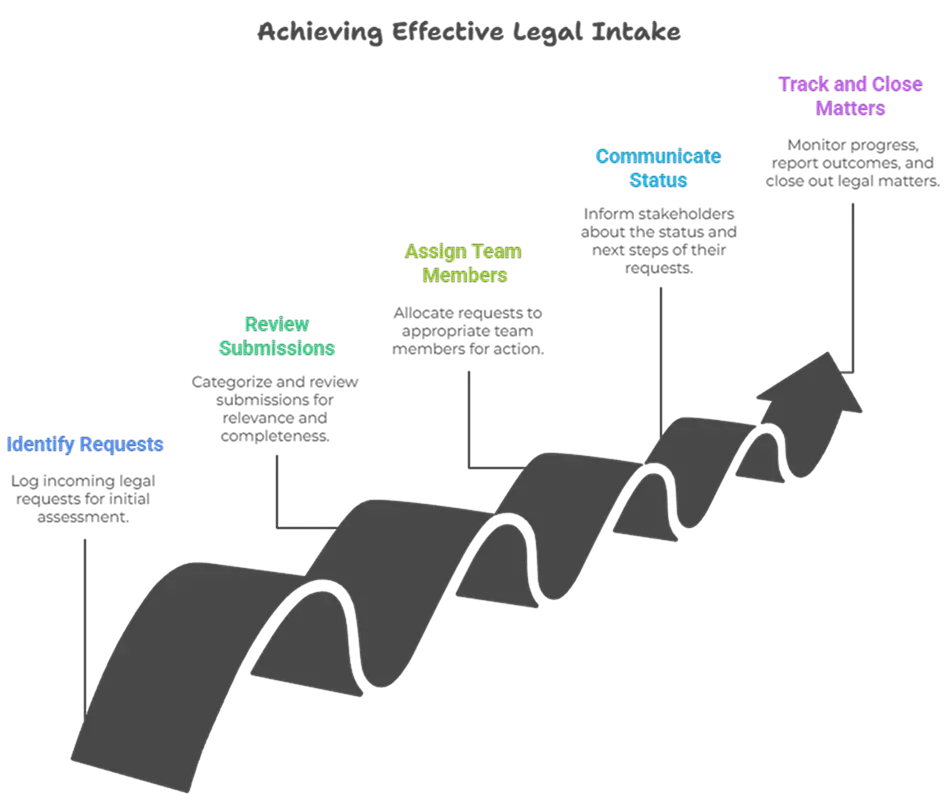Krunal Shah
Jul 31, 2025
Key Highlights
Gain clarity on what the legal intake process entails and why it is critical for law firms and in-house legal teams.
Understand how manual and automated intake workflows differ, including their challenges and benefits.
Explore the step-by-step stages involved in an effective legal intake process, from receiving requests to closing cases.
Learn about essential tools, forms, and software solutions designed to optimize client intake.
Discover best practices for legal intake form design and workflow setup.
Get insights into integrating intake systems with broader business tools and contract management software.
Legal intake is the backbone of strong, efficient connections between attorneys and people who may want their help. Whether you work in a law firm or need to handle tasks within legal departments, a good intake process helps you talk to others and get work done the right way. This guide explains legal intake clearly.
It will show legal professionals easy ways and tools that help them to make things work faster and better. If you are new to intake workflows in law firms or want to improve how your team works, this article will give you useful tips. These tips help teams boost their effectiveness and be more responsive to prospective clients and others they work with.
What Is Legal Intake? A Simple Explanation for Beginners

Legal intake is the step-by-step way that legal professionals use to gather and review information from prospective clients or people inside their company who come to them with legal matters. They use forms or tools like CLM software during this intake process to collect the key facts about the case or request. This process helps them with case qualification and risk assessment. By doing this, they make sure resources, like time and effort, go to the right places and no important issues get missed.
If you are new, understanding why this first step of the intake process matters is key. No matter if you are bringing new prospective clients into a law firm or handling business requests in legal departments, doing intake well makes things run smoother. A strong intake process also sets up a good base for everything that happens next in case management.
The Role of Legal Intake in Business Operations
Legal intake has a big effect on how businesses work, both in law firms and in legal departments. When you gather all the important client details at the start with the right intake process, it helps stop the mess that often comes up when handling new requests. This smoother workflow lets the legal team act fast and plan how to use their time and skills in the best way.
Using an intake process in legal departments also helps with risk management. By catching problems early, such as spotting possible conflicts or strange issues, the team can avoid big mistakes later. When you notice things like problems with rules or steps at the start, it saves time and money in the long run. Being faster and better here leads the team to make good decisions and get better results.
The intake process also makes a company more flexible. When you collect correct data, sort it, and keep track of it well, you help the team work better. With this good way to organise information, everyone—from the clients to the legal team and other important people—sees the benefits. It brings trust, better work, and more success to the business.
Key Terms Every Beginner Should Know
Understanding the main words used in the legal intake process can help make things clearer for you. Here are five key terms that every beginner should know:
Client Intake Process: This is the step-by-step way to get information from clients or people who need help.
Intake Form: This is a sheet or an online page that collects details from the client for review.
Legal Requests: These are questions or problems that people send to the legal team for help or advice.
Case Management: This means looking after legal matters and keeping track of them as they go on.
Practice Area: This shows which part of law the case is about, like contracts or jobs.
Knowing these words will help the legal team and clients work together in a better way. It also helps stop mistakes and slows things down less. When you put these things together, you get a good intake process for legal matters.
Why Legal Intake Matters for In-House Legal Teams

Legal intake is important for in-house legal departments. These teams get a lot of requests, often from many parts of the company. The requests can be about things like following rules or solving intellectual property issues.
Having a clear intake process helps handle these requests in the same way every time. It also helps the team decide what needs to be done first and where to put their resources. This makes answers better and helps people avoid problems like doing the same work twice or missing a due date. For legal departments that want to show their value to the organization, having a strong intake system is a good way to show they work well and support the business.
Common Use Cases in Corporations
Companies run into many situations where intake processes for the legal team are very important. These help people plan for what they need and let each department work in a better way:
Contract Reviews: Keep track of deals that are about to run out or need any changes.
Compliance Queries: Stay on top of questions about rules that staff send to the legal group.
Employment Issues: Deal with complaints at work or inside trouble right away and in the right way.
Intellectual Property Cases: Handle new patent, brand, or copyright problems.
By using these models, teams can have better intake steps. This helps the business meet its goals and bring down risk with the help of good forms and tools.
Impact on Efficiency and Risk Management
An effective legal intake setup can really help a department work better and faster. When you bring in automation to the intake process, it cuts down on manual work like sorting emails or looking for missing information. This means legal professionals have more time to work on important jobs.
Having a good setup for intake, with automation, also helps with risk management. The system can spot missing data or find strange details in the intake early. For example, with automated alerts about incomplete or mixed up case details, the team can avoid costly mistakes or delays.
When the setup for intake and automation work together, responsiveness grows. Legal professionals meet deadlines with more confidence, keep work flowing well, and can better work with other teams in the business.
Manual vs. Automated Legal Intake: Key Challenges and Benefits
Manual legal intake can be slow and full of mistakes. There is often more admin work for staff. People have to do the same jobs again and again. This is how more errors and delays happen.
Aspect | Manual Legal Intake | Automated Legal Intake |
|---|---|---|
Administrative Work | Repetitive administrative work | Streamlined processes |
Response Times | Slower response times | Enhanced responsiveness |
Team Focus | Limited focus on higher-value tasks | Allows focus on higher-value tasks |
Overall Client Experience | Standard intake experience | Significantly improved experience |
Common Pitfalls of Manual Legal Intake
Manual intake methods often cause problems that get in the way of a smooth workflow. These problems are:
Error-prone Data Entry: People make typing mistakes more often when there is no automatic check.
Slow Responsiveness: Having to follow up by hand slows things down and keeps clients waiting.
Retrieval Challenges: Digging through paper files can waste a lot of time when things need to happen fast.
Heavy Administrative Workloads: Staff end up with too much to do, which hurts the way the whole team works.
Fixing these problems is key for any firm that wants a better intake process, smoother workflow, and improved responsiveness. It will help people do their jobs better and make the most of all their resources.
Advantages of Automating Your Legal Intake Process
Automation changes the way legal intake works by using AI and special software platforms to make workflows smooth. This helps more than just saving time. It also makes clients much happier and cuts down on mistakes people can make.
Efficiency Enhancement: Streamlines the legal intake process and enhances efficiency
Administrative Relief: Frees up legal professionals from administrative work
Strategic Focus: Enables teams to focus on high-value tasks like assessing clients and managing case files
Rapid Response: Improves responsiveness through faster communication of next steps
Inquiry Tracking: Facilitates better tracking of inquiries
Data Accuracy: Ensures accurate data capture via intake forms and client intake software
Step-by-Step Guide to Effective Legal Intake Processes

To set up a practical legal intake workflow, you need to follow some clear steps. First, find out what people need or want from you. Next, look at all the forms or requests they send in. After that, check the information for any mistakes to make sure it is right. Then, give each request to the right person on your team. These steps help make the intake process better and more efficient.
This easy-to-follow guide helps lawyers and their teams improve the way they handle new work. By using these steps, they can use their time and other resources in a way that helps their business do well.
Step 1: Identifying and Logging Legal Requests
Logging begins when you write down the important details about incoming queries. You can do this by hand or with digital tools like CRM systems. At this step, make sure to get things like deadlines, case details, and contact information correct.
Using a centralised tracking system helps make sure that no requests get missed. It also helps put work in the right order in your workflow. When you get this step right, the rest of the work will also go much smoother.
Step 2: Reviewing and Categorizing Submissions
The categorisation phase starts with some basic checks. These checks make sure that all the intake forms are complete. Next, legal requests get sorted by things like priority or practice area.
Making sure every submission is placed in the right spot helps everyone. Teams know their responsibilities right away. This can cut down on delays and remove time wasted on going back and fixing mistakes. Many categorisation tools also work with automation software. This helps the process move faster and makes everything run smoothly.
Step 3: Assigning Requests to the Right Team Members
Matching legal matters with the right specialists is important for good case results. The use of software that helps balance work lets you spend less time giving out tasks by hand.
Making the steps for giving out tasks clear can help with accountability and make things easier to see in each department. This way, clients get quick and expert answers that fit their needs.
Step 4: Communicating Status and Next Steps
Being honest in how you talk with clients helps build trust. After each job, clients need clear updates. Give them details about their case, what is happening now, and what they need to do next, like handing in papers.
Using email tools that send messages by themselves or ready-made email templates can save the team time. It also helps make clients happy on every way they talk with you.
Step 5: Tracking, Reporting, and Closing Out Matters
Tracking how a case moves forward and making reports is the last step in a legal matter. Centralized tracking dashboards help people watch the workflow easily. These dashboards also show which matters are slow so there can be a quick response.
Closing out means writing down clearly how the case ended. It also means saving the records in order, and using what is learned to make your intake and workflow better for next time.
Essential Tools and Resources Needed to Start Legal Intake
Getting started with legal intake means using important tools like case management software, forms with set rules, and automation platforms. These tools help join tasks together and cut out repeated work.
From forms that can change with conditional logic to AI-powered triage systems, finding the right tools for your team’s size and needs helps you work better as legal professionals. The right tools will make intake easier and keep things running smoothly.
Legal Intake Forms and Templates
Effective legal intake forms and templates help to make the client intake process easier for law firms. These documents gather the client information you need, like contact details, facts about the case, and any unique needs the client may have. This lets legal professionals see if a new client is a good fit for their firm. If you use templates for your intake, you can save time on administrative work and have fewer mistakes.
Adding automation tools to the intake process can help the workflow move even better. This helps people at law firms talk to prospective clients more easily. It also makes the intake process faster and improves how quickly their team responds to others. By using good intake forms and new client templates with automation, law firms can make the entire client intake process smoother.
Legal Intake Software Options for Beginners
Choosing the right legal intake software can help make the client intake process easier for new leads. Many beginner-friendly options come with automation and CRM tools, making it more efficient and quick to respond. You will find things like ready-made templates for client intake forms and case management, which help with everyday administrative work for legal professionals. When you explore these easy-to-use options, it becomes simple for law firms to meet the unique needs of their prospective clients. This will help capture all the needed client information in a clear and quick way.
Related Article: How to create a CLM Software RFP
Conclusion
To sum up, having a good legal intake process helps law firms do better in their work and keep clients happy. When legal professionals use tools like client intake software and automation, they can make the intake process faster and easier. This also helps them take care of prospective clients in a simple way. Making sure there is easy access to information and that they respond quickly is important for every new client, as each one has unique needs. When a firm keeps up with legal trends, it can handle case management better and grow in the future. This will also help cut down on administrative work and problems, like inefficiencies, in the intake process.
Frequently Asked Questions
What information should be included in a legal intake form?
A legal intake form should have the client's contact details. It should list the type of case, the important dates, and the main legal issues. If there were any previous times the client got help from someone else, you need to include that as well. The intake form might ask the client to share some documents and a short written story of what happened. This helps the legal team get a good idea about the case right from the start.
How does legal intake software integrate with CLM systems?
Legal intake software helps your Contract Lifecycle Management (CLM) system work better. It makes data collection and storage automatic. This helps make contract management easy, makes it better for people who work together, and helps follow rules. The process is faster and has less mistakes. In the end, it saves time during legal work.
What are the most important metrics to track in legal intake?
The most important things to watch in legal intake are conversion rates, how long it takes to finish intake, client satisfaction numbers, and how fast you respond to follow-ups. If you track these, you can make the whole process better. It can help you work faster, give people a better experience, and get good results.
Can small legal teams benefit from automated intake processes?
Of course! Small legal teams can really get better at what they do by using automated intake processes. These systems help to collect data in a simple way and cut down on mistakes. With intake automation, your team can use their time well. They do not have to spend so much time on paperwork. This lets their team focus on work that is most important and gives clients a better experience.
About the Company
Volody AI CLM is an Agentic AI-powered Contract Lifecycle Management platform designed to eliminate manual contracting tasks, automate complex workflows, and deliver actionable insights. As a one-stop shop for all contract activities, it covers drafting, collaboration, negotiation, approvals, e-signature, compliance tracking, and renewals. Built with enterprise-grade security and no-code configuration, it meets the needs of the most complex global organizations. Volody AI CLM also includes AI-driven contract review and risk analysis, helping teams detect issues early and optimize terms. Trusted by Fortune 500 companies, high-growth startups, and government entities, it transforms contracts into strategic, data-driven business assets.








